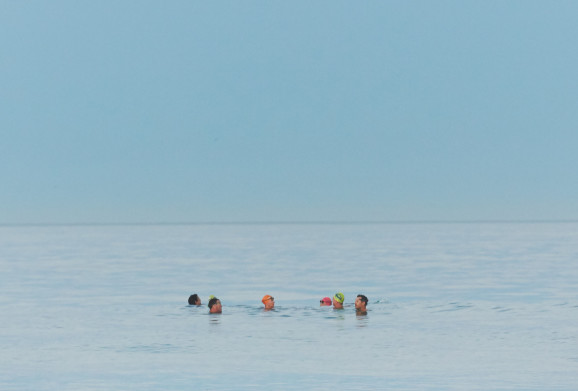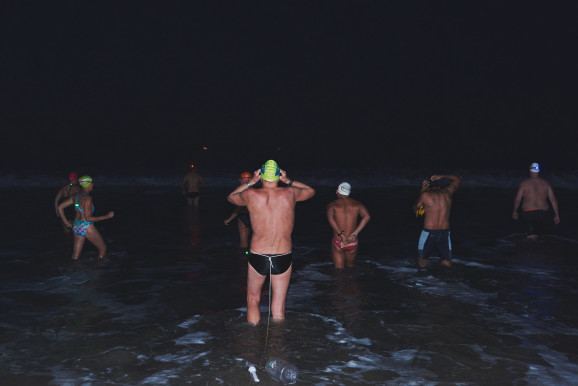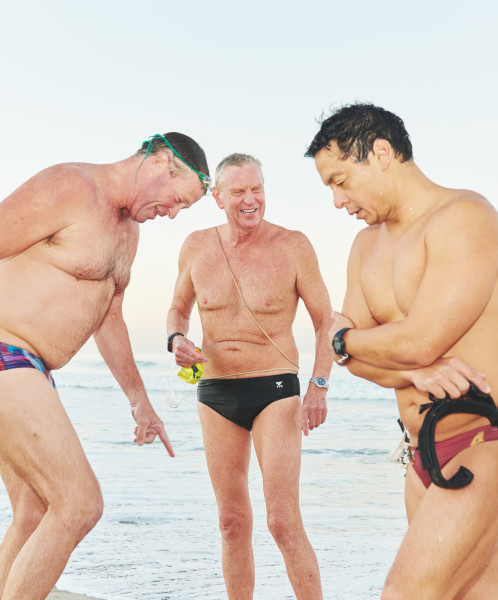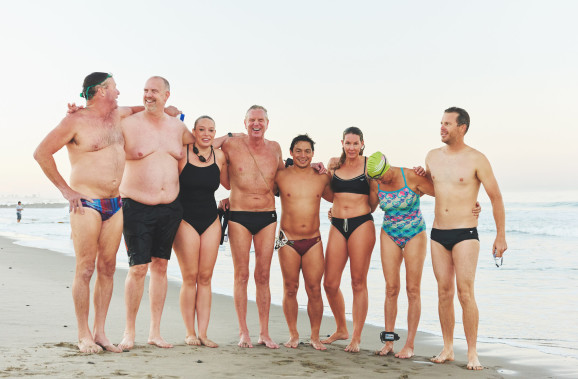Off the California Coast, a Swim Club’s Greatest Adventure

VENTURA, Calif. — Their sensible cars and light pickup trucks rolled into the beach parking lot before dawn Saturday. One by one, eight barefoot swimmers dressed in Speedo racing suits and fleece trench coats emerged from the vehicles, waving to one another, rubbing their eyes, smiling and stretching.
The bars and cafes on Seaward Avenue were dark and dormant, and a hairline crescent moon floated above the slumbering motel rooftops and rugged coastal mountains, silhouetted against a sky that was just a few shades more blue than black.
Once a week in the winter, and five days a week during summer and fall, a local group called the Deep Enders, an elite corps from the Buenaventura Swim Club, gathers here to swim in the ocean before sunrise. On Saturday, as always, they affixed waterproof lights to the straps of their goggles or to their waistbands — “so they can find our bodies,” Tom Ball, 55, a longtime member, joked as the group assembled on the beach.
“It’s just a 20- to 25-minute swim today,” said Jim McConica, 64, the group’s leader and a Southern California swim legend few have heard of outside the Ventura pool, where he and the others train when they are not in the ocean. He gestured toward the large house on the shore, 500 yards down the beach.

“We’ll go out to the white house and back,” he said.
The Deep Enders’ typical training swim, out to the Ventura pier and back, is more than three miles, which they swim in just over an hour. “We’ve been tapering all week,” said John Chung, 45, another member of the group.
Over the space of five days, McConica had clipped the usual distance of 6,000 yards by 1,000 yards each day, hoping to round the team into peak form as it prepared for a 70-mile channel relay crossing from San Nicolas Island to the Palos Verdes peninsula on the California mainland. If the team is successful, it will be a first in open-water swimming.
After the swimmers traveled by boat from San Pedro, Calif., on Sunday night, the event began at 7 a.m. Monday. McConica expected it to take 36 hours to complete, which would place mainland landfall just before sunset Tuesday. The swim can be tracked online.
Along the way, the six participating swimmers each planned to take one-hour shifts and, according to forecasts, deal with a swell of five to seven feet, enough to make a swimmer seasick. Then there are the island’s native elephant seals and their predators, great white sharks, to consider — not to mention the sheer exhaustion of it all.
On Saturday, the group that worked out was made up of five men and three women (including each member of the relay team and its crew chief, Theo Schmeeckle), six of them on the backside of 40 years old and all with serious swims on their résumés, including crossings of 12 to 21 miles from the Channel Islands of California to the mainland.
Aside from Ball, a music teacher and martial arts instructor, and Chung, a dentist, the group included an engineer, a schoolteacher and a lifeguard: McConica.
Muscular and slim at 6 feet 3 inches and 180 pounds, McConica 12 years ago became the oldest lifeguard to graduate from rookie school in Southern California, earning a spot in his class by blitzing his classmates — almost all of whom were collegiate-level swimmers in their 20s — in the grueling, run-swim tryout when he was 52 years old.
With waves thrashing the shoreline on Saturday, the Deep Enders jogged into the surf and swam through the breakers. McConica, the fastest of them all, towed a Gatorade bottle filled with a bit of seawater to create drag so he would not swim too fast for the others. The group members swam shoulder to shoulder because in open-water races, athletes are not allowed to draft. They carved through the water effortlessly, their green and red lights bobbing above a black sea, against a brightening sky.

A Group Effort
The crown jewel in what is known as open-water swimming’s Triple Crown is the 21-mile crossing of the English Channel from England to France. The crossing from Catalina, the most famous of Southern California’s offshore islands, to the mainland is considered the second hardest, although the circumnavigation of Manhattan receives more attention.
In such sanctioned open-water swims, athletes must have at least one kayaker by their side and a support boat with an independent observer on board approved by whichever record-keeping organization manages that particular channel — in this case, the Santa Barbara Channel Swimming Association.
The Deep Enders, who are not sponsored, paid a combined $12,000 out of their own pockets to attempt the San Nicolas crossing and recruited family members to spot them by kayak.
No matter the swim, the rules do not vary much. Swimmers are forbidden to wear wet suits or fins, and they are not to be purposefully touched by their support team. When food or drinks are offered, they must be presented on a tray while the swimmer treads water.
The easiest of the Channel Island swims is the 12-mile crossing from Anacapa to Ventura. All of the Deep Enders have made that crossing. McConica swam it in 4 hours 38 minutes three years ago, beating a record set three weeks earlier by a college swimmer. He also holds the record for the 19-mile Santa Cruz Island crossing, 8:59, set in 2013. But McConica had a swim career long before he was an open-water god.
At the University of Southern California in the early 1970s, he won six N.C.A.A. gold medals, and he once beat Mark Spitz by a body length in the opening leg of a freestyle relay. His team, however, twice finished second to Spitz’s Indiana team and never won a national title. That is one of two major disappointments that haunt and drive McConica still. The other is missing a berth on the 1972 Olympic team by a tenth of a second (although he was part of a 1971 world-record relay team).
After college, McConica left the pool and the sport behind. He received a Master of Business Administration degree and bought his father out of the family’s car dealership. But in 1981, with his two young daughters getting a bit older, he found himself watching “ABC’s Wide World of Sports” and feeling, he said, like a bump on a log — that he never fully realized his athletic potential. He knew he had to do something. Ten days later, he swam the Catalina Channel.
At the time, McConica had only recently begun swimming with the Buenaventura Swim Club, and he was still a sprinter who had never trained for distance. He finished the crossing in just over nine hours and could not lift his arms over his head for two weeks, he said. A month later, he started training for distance in earnest, and the next year he set the Catalina Channel record when he swam it in 8:27. Five years later, at 37, he swam the English Channel.
In recent years, he has had as much fun training with and helping coach the Deep Enders as he has had accomplishing individual goals. The group’s seminal moment came in 2010 when McConica led a relay of six swimmers, the so-called Deep Six, which included Chung and Ball, on a 202-mile open-water course that departed from Ventura and wandered north to Santa Barbara before turning back south to La Jolla Cove in San Diego.
For four days and nights, the six athletes traded off, swimming an hour at a time, to bridge the distance. It was the longest relay of its kind in history. The previous record was 78 miles.
The Deep Six swim was not easy. The Pacific was unseasonably cold that year, with temperatures as low as 54 degrees. Wet suits were not allowed. Besides, McConica considers the desire for warmth a form of weakness, so he would not wear one anyway. In addition, there was a stiff current, and the swim stretched a day longer than they had hoped, which meant they ran out of food and energy drinks to sustain them.
“The group was really positive,” Chung said. “We knew that there would be challenges, but we made an agreement that we would get through this together, and nobody wanted to let their teammates down.”
Ball, a former college swimmer who started swimming again in his late 40s after his weight hit 270 pounds and he received a diagnosis of Type 2 diabetes, remembers one particular bit of McConica wisdom that helped on that swim.
“Get your mind right,” Ball said. “It’s a simple statement but profoundly true. We’ve endured some pretty unreal conditions when the water is 50-something degrees and you’re miles from shore and it’s pitch black, but to accomplish these things, you need to have the mind-set that I will get this done.”
Zach Jirkovsky, 34, who led off the San Nicolas swim Monday morning, said: “He’s like Yoda sometimes. I can hear him in my head.”
Setting an Example
The swimmers listen, not just because of McConica’s accomplishments but because they have often seen him push himself to the point of vomiting and persevere anyway. In August, he tried to become the oldest person to swim the Catalina Channel, and it was a miserable swim almost from the start.
Chung was swimming with him that night (takeoff was after 10 p.m.), and so was Tamie Stewart, 42, a teacher, a single mother and the newest Deep Ender. Three hours after departing Catalina, McConica hit the wall.
“Then came the diarrhea and the nausea,” he said. “I couldn’t eat, so there were no breaks. When the sun came out and I could finally see, I kept looking and hoping for a great white to come and put me out of my misery.”
No such luck. Instead he turned to each side and saw his teammates swimming alongside him, shoulder to shoulder, and knew he could not let them down.

“Mental strength was absolutely critical,” he said.
He made it, of course.
On Monday, McConica followed Jirkovsky and swam the second leg, followed by Chung; Stacey Warmuth, 59, who won six national masters swim titles this year; Ball; and Stewart.
Although the entire team was integral to organizing the attempt, it was Jirkovsky who hatched the idea of a San Nicolas crossing.
Beloved by divers, surfers, spear fishermen, hikers and birders, Southern California’s eight Channel Islands run from Long Beach to Point Conception, north of Santa Barbara. Five of them make up a national park; all are home to endemic plant and animal life and are sanctuaries by official designation or by nature for marine mammals.
San Nicolas is the farthest from shore and the most shrouded in mystery. The island, a rugged 23 square miles, is featured in a children’s novel, “Island of the Blue Dolphins,” based on the true story of a 19th-century indigenous woman left stranded there for 18 years. The book is commonly taught in Ventura primary schools, Jirkovsky and Stewart said.
These days, the island’s rolling hills, virgin coves and sheer cliffs are the domain of both the United States Navy and elephant seals, which are not known for their hospitality and often grow to 16 feet and more than 6,000 pounds.
On Sunday night, the plan was for Jirkovsky to swim to shore from the team’s 63-foot support boat, the Bottom Scratcher, which was required by the Navy to remain 300 yards offshore. He would set foot on Cissy Cove at 7 a.m. and then begin swimming toward the mainland at a pace of more than two miles an hour.
Swimmers must maintain their order throughout the attempt for it to qualify as an official crossing. If they grow tired, they do not have to swim but must stay in the water for the full hour.
Aside from those seals, hazards the team might be encountering include sharks; there has been a recent uptick in sightings and attacks. On Saturday morning, Ball showed off the T-shirt he designed and had printed commemorating the attempt. It included an image of a hammerhead.
“Hammerheads are really in right now,” he said. “I mean, they are really in. A friend of mine was bit by one two weeks ago.”
But the real obstacle in a channel crossing of this kind tends to be the ocean itself, which can and often does deliver unpredictable swells and currents at any time. On Sunday night, when the group members gathered for dinner at a seafood restaurant at the San Pedro marina before they shoved off, they heard news of a swimmer who had begun a first attempt at a crossing from San Nicolas to Santa Barbara Island the day before. He quit after three hours, physically and mentally spent, and violently ill. The swell and the current were stiffer than he had anticipated and more than he could bear.
The swimmers understand how capricious the ocean can be. It can deliver spectacular beauty, through midnight phosphorescence, breaching gray whales or playful dolphins at sunrise. But there is often a dose of pain and a stiff challenge to overcome, too.
“The ocean is different every day, and you have to be prepared to be able to deal with whatever it throws at you,” McConica said. “It’s a way different situation out there beyond Catalina, where you aren’t protected by the other Channel Islands. That’s the real open ocean.”
If the group is successful, McConica said, all of the sacrifice and suffering will have been more than worth it.
“When you accomplish a channel, you have this inner peace, a sense of pride and satisfaction that lasts a long time,” he said. “We just hope the channel gods give us a shot.”
Just after 9:30 p.m. Sunday, the Bottom Scratcher shuddered to life, backed out of its slip in the San Pedro marina and headed for the open sea. The night was warm, the wind mild and team morale high. Whatever the channel gods had planned for the Deep Enders was anybody’s guess.
